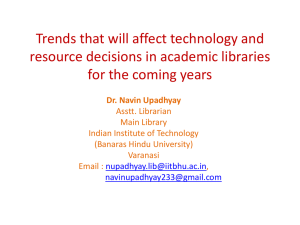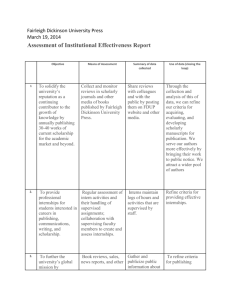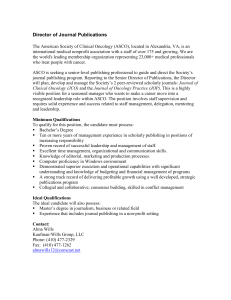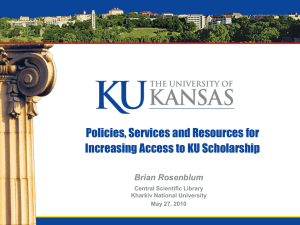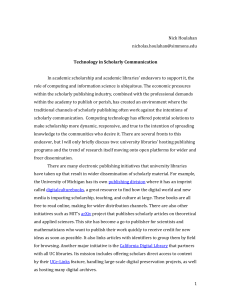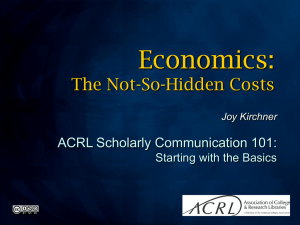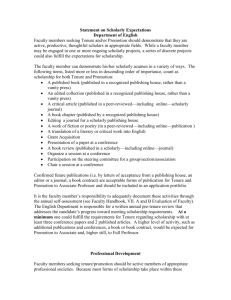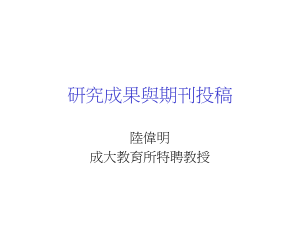ALCTS Association for Library Collections
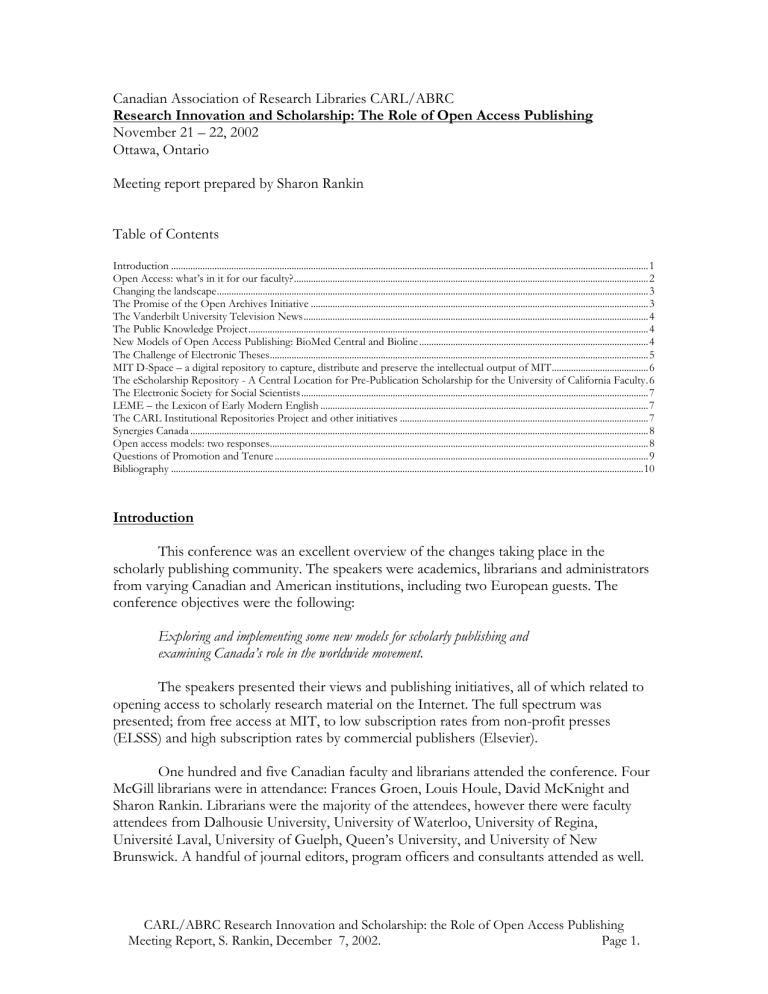
Canadian Association of Research Libraries CARL/ABRC
Research Innovation and Scholarship: The Role of Open Access Publishing
November 21 – 22, 2002
Ottawa, Ontario
Meeting report prepared by Sharon Rankin
Table of Contents
Introduction
This conference was an excellent overview of the changes taking place in the scholarly publishing community. The speakers were academics, librarians and administrators from varying Canadian and American institutions, including two European guests. The conference objectives were the following:
Exploring and implementing some new models for scholarly publishing and examining Canada’s role in the worldwide movement.
The speakers presented their views and publishing initiatives, all of which related to opening access to scholarly research material on the Internet. The full spectrum was presented; from free access at MIT, to low subscription rates from non-profit presses
(ELSSS) and high subscription rates by commercial publishers (Elsevier).
One hundred and five Canadian faculty and librarians attended the conference. Four
McGill librarians were in attendance: Frances Groen, Louis Houle, David McKnight and
Sharon Rankin. Librarians were the majority of the attendees, however there were faculty attendees from Dalhousie University, University of Waterloo, University of Regina,
Université Laval, University of Guelph, Queen’s University, and University of New
Brunswick. A handful of journal editors, program officers and consultants attended as well.
CARL/ABRC Research Innovation and Scholarship: the Role of Open Access Publishing
Meeting Report, S. Rankin, December 7, 2002. Page 1.
The list of participants is contained in the meeting binder prepared for all attendees.
Their names are not included on the CARL/ABRC web site. The binder also contains a number of useful reading materials (see Bibliography on page 10) as well as biographical sketches and project information.
This meeting report contains highlights and remarks from each session. At times the question periods were spirited and controversial, but what I found impressive was the sense of humor and respect for differences of opinion displayed by all.
“An old tradition and a new technology have converged to make possible an unprecedented public good. The old tradition is the willingness of scientists and scholars to publish the fruits of their research in scholarly journals without payment, for the sake of inquiry and knowledge. The new technology is the internet. The public good they make possible is the world-wide electronic distribution of the peer-reviewed journal literature and completely free and unrestricted access to it by all scientists, scholars, teachers, students, and other curious minds. Removing access barriers to this literature will accelerate research, enrich education, share the learning of the rich with the poor and the poor with the rich, make this literature as useful as it can be, and lay the foundation for uniting humanity in a common intellectual conversation and quest for knowledge.
(From the Budapest Open Access Initiative Web Site at http://www.soros.org/openaccess/ )
Thursday, November 21, 2002
Open Access: what’s in it for our faculty?
Jean-Claude Guédon , Université de Quèbec (History of Science Professor) provided an opening historical perspective on scholarly publishing since the Royal Society beginnings in the 16 th century. Just what is the scientific game? Scientists want to go public with their research, have a wide circulation of readership and want to be judged as being the creators of valuable symbolic capital.
The scholarly publishing undertaken by commercial enterprises post World War II, has contributed to the development of a scientific elite and publishers with inelastic markets.
Scientists and scholars are only now beginning to understand what the true costs are.
Libraries have tried to buffer and hide the issue. The print peer review journal editorial board does not give scientists what they need. Its’ dynamics need to be questioned. It leans on a social system of non-academic interests (i.e. perks, quota payments, copyright control).
It is in the best interests of scholars and scientists to support open access and allow an entire community to decide what is significant. It is time to rebuild the community of science. The few small Canadian academic journal publishers will soon be candidates for corporate buyouts. SSHRC should ensure funds are directed to open access initiatives rather than society toll gated publishers.
CARL/ABRC Research Innovation and Scholarship: the Role of Open Access Publishing
Meeting Report, S. Rankin, December 7, 2002. Page 2.
Changing the landscape
Rick Johnson , is the director of SPARC (the Scholarly Publishing and Academic
Resources Coalition), an international library alliance built as a constructive response to market monopolies in scholarly publishing. His remarks focused on three areas: describing the initiatives that are pushing change, how the open archives initiative breaks apart scholarly publishing functions and how libraries should become involved.
Faculty expectations, institutional objectives, a networked digital environment and the serials crisis are all pieces that have come together for compelling change.
Rick described the scholarly publishing functions: registration of intellectual property, certification of the quality of research, awareness and accessibility, and archiving for future use. Traditional journals integrate these functions. OAI breaks apart these functions. The monopoly on content is broken and the OAI model allows each function to be done by different groups who add value and create services that make the parts work together.
Libraries should be regaining faculty partnerships, revitalizing existing ones or creating new ones. The open access initiatives advance core library values and create new roles for librarians, bringing them closer to authors. Librarians should take a look and see how to get OAI working with faculty, promote readership and contribution to OAI web sites on campus and cancel overpriced journals.
The Promise of the Open Archives Initiative
Simeon Warner is working as a developer of the e-print archive software and sits on the Technical Committee developing and maintaining the OAI standard. The OAI specifies a technology standard for sharing many forms of research content. The general solution and framework for the OAI standard is complete. Work is continuing on the technical solutions to pull disaggregated content together.
The OAI model views the landscape has having many different networked partners.
Some may be commercial and will do different aspects of scholarly publishing functions.
The academy adds the real value and commercial ventures should not hold the content ransom. Service provider layers will add value for functions most appropriate to them.
Scholars as authors and readers need a unified discovery tool, toll free access to full content and new services. Institutions need lower costs for literature and better control of scholar output. With open access, funding bodies will have the widest possible dissemination of research and will not have to buy back research they have funded.
CARL/ABRC Research Innovation and Scholarship: the Role of Open Access Publishing
Meeting Report, S. Rankin, December 7, 2002. Page 3.
The Vanderbilt University Television News
Paul Gherman , University Librarian at Vanderbilt University presented the
Vanderbilt Television News Archive and described a unique source of cultural history information and the difficulties Vanderbilt University is experiencing to improve access and to preserve and archive this collection. The University has been underwriting the cost of this service and as of March 2003 this will no longer be possible. Paul now has the responsibility to find a funding model that will sustain this collection and keep access as open as possible.
The meeting binder contains a paper summary of the News Archive objectives and future goals.
The Public Knowledge Project
John Willinsky , University of British Columbia,Pacific Press Professor of Literacy and Technology is the director of the federally funded Public Knowledge Project , an
“initiative that seeks to improve the scholarly and public quality of academic research through innovative online environments. It is testing whether more open, coherent, and integrated systems for scholarly
communication can advance the global exchange of knowledge within the public sphere.”
Background reading on the conceptual model for the project can be found in
Current issues in Education, [Online], 3(6), 2000.
The PKP is OAI compliant, uses Dublin Core metadata standards for descriptive records and asks authors to create metadata as part of the publishing process. John described some of the features of the system that contribute to effective peer review; thank you submission buttons, links to related studies, author’s biographical links, government links, and recently published articles on similar topics. The PKP software will be made at free of charge as open source.
John encouraged librarians to expand their role beyond mere depositories and become involved in the improvement of scholarship by working and contributing to open archive initiatives.
New Models of Open Access Publishing: BioMed Central and Bioline
BioMed Central and Bioline are both publishing ventures devoted to open access for science research.
Jan Velterop , BioMed (BMC) publisher debunked a number of open access myths.
Peer review is the same or better in BMC. The journals enhance scientists’ visibility and chance to be cited by others. BMC statistics show hit list numbers far higher than expected.
The average number of BMC journal downloads is 4,000 per month, compared to Elsevier’s
5.6 per month.
Authors keep their copyright in BMC journals and pay a fee (500 Euros) for each article submission. Fees are waived upon request from scientists who cannot afford the amount. Fees are accepted only if the article is published. The Faculty of 1000 feature is a new online research tool that highlights the most interesting papers in biology, based on the recommendations of over 1000 leading scientists
.
CARL/ABRC Research Innovation and Scholarship: the Role of Open Access Publishing
Meeting Report, S. Rankin, December 7, 2002. Page 4.
Leslie Chan explained that Bioline is a service provider for journal publishers in the developing world. It operates on a cost recovery basis with a small amount of funding from
INASP . The University of Toronto does the document conversion, coding and XML and the files are then ftp’ed to the BioLine server in Brazil, where the system is supported.
Documents are kept in html rather than pdf format to ensure scientists with small bandwidth and high Internet costs can read and submit. Future directions are planned for
XML full text, multilingual capability and OAI compliancy.
The Challenge of Electronic Theses
This session was a panel discussion about three electronic theses projects, moderated by Bill Maes (CARL President and University Librarian at Dalhousie University.)
Dr. Fernand Gervais , Vice-doyen à la transformation, Faculté des études superièures a Université and Guy Teasdale Spécialisteé en ressources documentaires, Direction de la
Bibliothèque de Université Laval described their ETD project that has moved ahead with renewed support from the Dean in the Faculty of Graduate Studies. 14 e-theses now exist and plans are underway to extend e-submission to graduates in 2003. A Web CT course was created to train students in the style sheet and advanced word processing features used to prepare manuscripts. The Library prepares the cataloguing; Dublin Core metadata plus four or five additional elements including an English abstract. Theses will be searchable on the
Erudit website (OAI compliant) and Laval would like to streamline procedures so that a thesis can be online within days of student completion.
Sharon Reeves, Head, Canadian Theses Service , National Library of Canada announced plans for a Canadian thesis portal to be launched next year. Funds have been secured for the project and an Advisory Committee has been created to work with NLC. A technical subcommittee for metadata will be created. NLC would like to develop guidelines and a tool kit for Universities to use for e-thesis creation and submission. NLC is currently reviewing its relationship with UMI and an important part of this new project will be digital preservation and participating in the NDLTD Union Catalogue.
Dr. John Lennox , Professor of English and Dean of Graduate Studies at York
University summarized a report from the University committee, which he chaired. The
Committee prepared academic principles concerning e-theses by surveying all graduate program directors. These include: archival format very important (pdf for text), a written interpretation is necessary for all non-text theses, students should follow UMI guidelines for multimedia, student has the responsibility to ensure that all reviewers have the same copy and e-submission would is viewed as an option only.
CARL/ABRC Research Innovation and Scholarship: the Role of Open Access Publishing
Meeting Report, S. Rankin, December 7, 2002. Page 5.
Friday, November 22, 2002
MIT D-Space – a digital repository to capture, distribute and preserve the intellectual output of MIT
Mackenzie Smith , Associate Director for Technology at MIT outlined the context, technology and objectives for the MIT D-Space open archive repository: an MIT and HP technology alliance. The software was created as a response to faculty requests for the
Library to store faculty work (raw research data, preprints & papers) in a multitude of formats. Web CT materials and courses are not archived in the Web CT system and faculty wanted to have this work preserved as well. The project goals were based on the widest possible acceptance of faculty requests, and the system was designed to accept as the discipline specific ‘personalities’ of each faculty. The project has the highest level of support from the MIT Administration and its business plan identifies opportunity costs and advantages to central management of the institution’s digital scholarship.
D-Space is based on a community model. The community defines the collection, selects items, uploads the files, creates the metadata and determines workflow for the deposits. The repository supports three levels of document formats: known (TIFF, SGML), known/unsupported (Word, PowerPoint) and unknown (bits). D-Space will accept any document format and does not do any file conversions. D-Space is built with open source software, is OAI compliant and is now available free of charge. There are 1,000 documents online to date and a goal of building a critical mass of content will be achieved with 7 other academic partners who will be using D-Space on their campuses. D-Space will archive MIT’s
Open Course Ware and SFX services will be added to link D-Space and MIT’s online catalogue.
The eScholarship Repository - A Central Location for Pre-Publication Scholarship for the University of California Faculty
Greg Tananbaum , President, Berkley Electronic Press described the work the press is doing for the University of California to create “ bepress ” software to enable the faculty to publish easily and promote their research. The software is not open source, but can be licensed by other institutions. The system has a number of features: easy submission process all formats of documents are accepted, flexible document hierarchy, alerting system, peer- review mechanisms, automatic conversion to pdf, automatic controlled vocabulary pick list for subject metadata and usage statistics. Currently 30 research units at the University of
California have added 45,000 documents. This review clip from the bepress web site is one of many very positive acclamations. “The launch of The Berkeley Electronic Press is welcome news for scholars and libraries. Their commitment to innovation and low prices offers an appealing alternative to high- priced journals. The Berkeley Electronic Press quality-rating system — in which articles are assigned to one of a range of bepress journals based on an evaluation of their relative merit - is intriguing. So is the "Authors & Reviewers' Bank".
And I suspect that bepress short submission-to-publication time will provide a decisive edge in winning authors and subscribers. This kind of competition is good for scholarly communication."
— Rick Johnson, Enterprise Director, Scholarly Publishing & Academic Resources Coalition
(SPARC)
CARL/ABRC Research Innovation and Scholarship: the Role of Open Access Publishing
Meeting Report, S. Rankin, December 7, 2002. Page 6.
The Electronic Society for Social Scientists
Manfredi La Manna , a University of St. Andrews, Economics Professor began his presentation with an analysis of who publishes the prestigious and most important economics journals and explained how the length of time to publish an article in the commercial or society presses was counted in months and often stretched to a 3 or 4 year wait. Elsevier has a 15.6-month publication delay in economics online journals and a further
8 to 14 months delay for the print version.
Manfredi and colleagues created the ELSSS non-profit organization, which is publishing a new e-journal, entitled ” Review of Economic Theory” that is targeted to be a direct competitor to the Elsevier journal, “ Journal of Economic Theory”.
ELSSS claims to have the best economics editorial board, honorariums are given to referees who complete their article reviews in less than five weeks, and its goal is to publish an article 1.5 months after receipt. The software has a number of features to enable postpublication interaction and also provides use statistics.
LEME – the Lexicon of Early Modern English
Ian Lancashire , University of Toronto, English Professor introduced himself as an open source scholar, actively being open to students in online courses and being involved in
Internet publishing of English dictionaries, poetry, and now with LEME, a web searchable lexicon of dictionary texts from 1475 and 1700. A ten-page description of LEME is contained in the conference binder. LEME is a joint research project funded by the
University of Toronto, the University of Toronto Library and Ian’s SSHRC grant.
The CARL Institutional Repositories Project and other initiatives
Jean Pierre Coté, Chief Librarian, Université de Montreal introduced the CARL initiative. A number of Canadian libraries have agreed to set-up institutional archives using open source software (E-print or D-Space), will enable federated searching and will share their experiences.
Kathleen Shearer, CARL research associate described the support CARL is making available for the project. She has written A Step by Step Guide to Setting Up an Institutional
Repository and maintains the project web site.
Marie-Hélène Vezina, Université de Montreal described the work to date to create
Papyrus , an OAI compliant institutional repository. Four classification schemes have been incorporated for subject access which in hindsight maybe too unwieldy for patrons. The Eprint web screens have been customized and translated into French.
All of the presentations in this session can be read on the web at http://www.carlabrc.ca/projects/institutional_repositories/member-e.htm
.
CARL/ABRC Research Innovation and Scholarship: the Role of Open Access Publishing
Meeting Report, S. Rankin, December 7, 2002. Page 7.
Synergies Canada
The Synergies project seems to be the gleam in the eyes of each of these presenters.
A web site does not yet exist and the project definition and grant application are being worked on. The goal is to create a pan-Canadian scholarly e-publishing system to open access (probably not free of charge) to Canadian research journals and to include cultural magazines.
David Moorman, Senior Policy Advisor reporting to the Executive Vice President of the Social Sciences and Humanities Research Council ( SSHRC) described a number of policy changes under discussion at SSHRC; special initiatives grants for journals moving online, changes to funding to cover only fund peer review and copy editing costs, enforcement of the policy that publicly funded research must be made publicly available. SSHRC is currently funding partial costs for 154 journals in Canada.
Rowland Lorimer , Simon Fraser University, School of Communication and Director of the Canadian Studies for Publishing described the Synergies project. Five universities will start to develop the software, building on the work on Erudit and the Public Knowledge
Project. The goal is to have 100 Canadian journals online as soon as possible.
Guylaine Beaudry, Director of Electronic Publishing in IT Services at Université de
Montrèal described the recently launched Erudit web site that makes available four types of
Quebec research; articles, pre-prints, theses, and books. The site is free until March 2003 and then the fee for use will be based on a cost recovery basis. All Quebec government funded journals must be made available on Erudit.
Open access models: two responses
Pieter Bolman, Director, STM Relations at Elsevier Science began his presentation with a historical overview. Commercial publishing rose to meet the demand of scientists in the ‘30s, a response not made by the learned societies and as a result have captured the market, become prestigious publishing venues and have been ‘forced’ to raise prices in the late ‘70s as academic collections budgets were reduced, inter-library loan delivery services increased and the costs of publishing and archiving increased. For 2003, Elsevier has capped its price increases at 5% and the big deals being offered to Libraries for print and electronic journals are transitional. The cost model for commercial publishing will change.
Bruce Danick, Editor - in -Chief at the National Research Council Press (NRC ) is responsible for 15 journals and 65 monographs of Canadian science, which have been freely available to all .ca Internet addresses as a result of special five-year funding from the
Canadian government. (Note: Attendees questioned the fee for other countries and many felt that Canadians would prefer to provide free access to all.) The cost of peer review has gone up 54% for NRC titles and revenue at some level is important to enable NRC to continue to publish and archive. An author payment model is not of interest to NRC.
CARL/ABRC Research Innovation and Scholarship: the Role of Open Access Publishing
Meeting Report, S. Rankin, December 7, 2002. Page 8.
Questions of Promotion and Tenure
Alan MacDonald, Special Assistant to the Provost at the University of Calgary moderated a panel of speakers who examined the implications of open source publishing for academic promotion and tenure. The panel members came from diverse backgrounds, each with varying degrees of involvement in the scholarly communication process.
Panel members were Bruce Dancik, NRC, Manfredi La Manna, St. Andrews, Pierre
François le Fol, Program Officer, SSHRC and John Rowcroft, Dean of Arts, University of
New Brunswick. In general there was consensus that if the e-journal had a good peer review process it was considered with the same value as a print publication for the promotion and tenure process.
CARL/ABRC Research Innovation and Scholarship: the Role of Open Access Publishing
Meeting Report, S. Rankin, December 7, 2002. Page 9.
Bibliography
1. 2nd Workshop on the Open Archives Initiative (2002) at http://documents.cern.ch/AGE/current/fullAgenda.php?ida=a02333
2. American Association of the Advancement of Science (2002) “ Electronic Publishing in
Science, Seizing the moment: Scientist’s authorship right the Digital age” at http://www.aaas.org/spp/sfrl/projects/epub/epub.htm
3. BioMed Central (2002) What is BioMed Central?” http://www.biomedcentral.com/info/
4. Budapest Open Access Initiative at http://www.soros.org/openaccess/
5. Canhos, Vanderlei and Chan, Leslie and Kirsop, Barbara (2001) ” Bioline Publications:
How its evolution has mirrored the growth of the Internet”, Learned Publishing, 14 (41) at http://eprints.utsc.utoronto.ca/archive/00000015/
6. Creative Commons News (2002) at http://www.creativecommons.org/news/may16.html
7. Crow, Raym (2002) “ The Case for Institutional Repositories: A SPARC Position Paper”,
ARL Bimonthly Report, no. 223 at http://www.arl.org/newsltr/223/instrepo.html
8. Crow, Raym (2002) “SPARC Institutional Repository Checklist and Resource Guide”,
Pre release draft, November 2002 at http://www.arl.org/sparc/IR/IR_Guide_v1.pdf
9. DARE: Digital Academic Repositories, SURF at http://www.surf.nl/download/DAREsummary.pdf
10. FIGARO Press Release (2002) at http://www.figaro-europe.net/news.html
11. Horvath, John (2002) “ Opening the Way for Open Research?” Telepolis, Verlag Heinz
Heise, Hannover, last modified: 15.04.2002. at http://www.heise.de/tp/english/inhalt/co/12242/1.html
12. JISC Circular (2002), Focus on Access to Institutional Resources Programme (FAIR) at http://www.jisc.ac.uk/pub02/c01_02.html
13. Johnson, Rick (2002) “Working together to reform scholarly communication”, C & RL
NewsNet, [Online], 63(9), October 2002 at http://www.ala.org/acrl/c&rloct2.html
14. Houghton, John (2002) “ The Crisis in Scholarly Communication: an Economic
Analysis” at http://www.vala.org.au/vala2002/2002pdf/16Houton.pdf
CARL/ABRC Research Innovation and Scholarship: the Role of Open Access Publishing
Meeting Report, S. Rankin, December 7, 2002. Page 10.
15. MacColl, John and Pinfield, Stephen (2002) “Climbing the Scholarly Publishing
Mountain with SHERPA”, Ariadne, Issue 33 at http://www.ariadne.ac.uk/issue33/sherpa/
16. Odlyzko, Andrew (1999) “ Competition and Cooperation: Libraries and Publishers in the Transition to Electronic Scholarly Journals”, Journal of Electronic Publishing, 4(4) June 1999.
Reprint at http://www.press.umich.edu/jep/04-04/odlyzko0404.html
17. Project Romeo at http://www.lboro.ac.uk/departments/ls/disresearch/romeo/
18. Steele, Colin (2002) “ E-prints: the future of scholarly communication?” inCite, October
2002 at http://www.alia.org.au/incite/2002/10/eprints.html
19. Solomon, David J. (2002) “Talking past each other: Making Sense of the Debate over
Electronic Publication”, First Monday, 7(8) at http://cogprints.ecs.soton.ac.uk/archive/00002426/
20. Suber, Peter. (2002, August) FOS Newsletter at http://www.earlham.edu/~peters/fos/sources.htm
21. Symposium on the Role of Scientific and Technical Date and Information in the Public
Domain (2002 September) National Academies, Washington, D.C. at http://www7.nationalacademies.org/biso/PublicDomainAbstracts.html
22. Willinsky, John (2002, November) “Copyright Contradictions in Scholarly Publishing”,
First Monday, 7(11) at http://www.firstmonday.dk/issues/issue7_11/willinsky/
23. Willinsky, John (2000, September) “ Proposing a knowledge exchange model for scholarly publishing”, Current Issues in Education [Online], 3(6) at http://cie.ed.asu.edu/volume3/number6/
CARL/ABRC Research Innovation and Scholarship: the Role of Open Access Publishing
Meeting Report, S. Rankin, December 7, 2002. Page 11.
